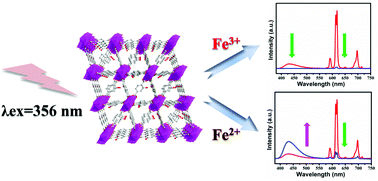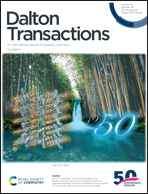A dual-emissive europium-based metal–organic framework for selective and sensitive detection of Fe3+ and Fe2+†
Abstract
A dual-emissive optical material as a ratiometric fluorescent probe has been demonstrated to be remarkably superior in precise and quantitative analyses. Herein, a novel dual-emissive fluorescent probe Eu-BDC-OH was designed and successfully synthesized using Eu3+ and 2-hydroxyterephthalic acid (H2BDC-OH) at room temperature. Eu-BDC-OH has a three-dimensional interpenetrating network structure with a large number of exposed hydroxyl functional groups, providing abundant active sites for molecular recognition. In particular, the as-obtained Eu-BDC-OH serves as a unique fluorescent probe, and the double emission peaks of both the ligand and Eu3+ are completely quenched by Fe3+. However, it is worth noting that the dual emissions of Eu-BDC-OH enable the ratiometric detection of Fe2+, which leads to an increase in ligand emission and a decrease in Eu3+ emission, accompanied by a distinct red to blue color transition. The relative fluorescence intensity ratio (I618 nm/I433 nm) decreased linearly with increasing Fe2+ concentration in the 0–50 μM range with a superior detection limit of 0.32 μM. In this work, a fluorescent probe based on a MOF was developed for the recognition of Fe2+ and Fe3+, providing a promising strategy for the synthesis of novel dual-emission materials by integrating suitable luminescent ligands with lanthanide metal ions.



 Please wait while we load your content...
Please wait while we load your content...